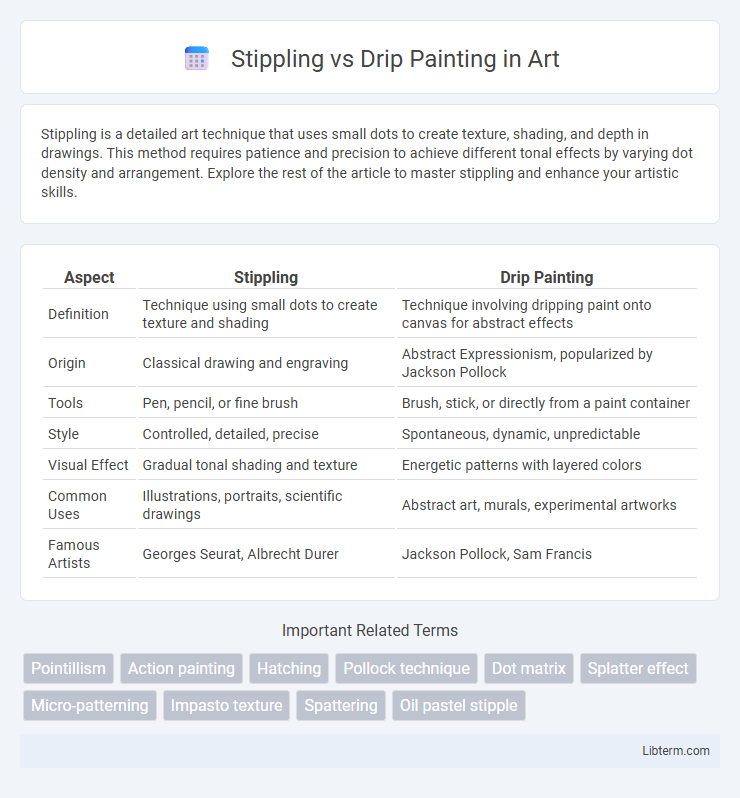Stippling is a detailed art technique that uses small dots to create texture, shading, and depth in drawings. This method requires patience and precision to achieve different tonal effects by varying dot density and arrangement. Explore the rest of the article to master stippling and enhance your artistic skills.
Table of Comparison
| Aspect | Stippling | Drip Painting |
|---|---|---|
| Definition | Technique using small dots to create texture and shading | Technique involving dripping paint onto canvas for abstract effects |
| Origin | Classical drawing and engraving | Abstract Expressionism, popularized by Jackson Pollock |
| Tools | Pen, pencil, or fine brush | Brush, stick, or directly from a paint container |
| Style | Controlled, detailed, precise | Spontaneous, dynamic, unpredictable |
| Visual Effect | Gradual tonal shading and texture | Energetic patterns with layered colors |
| Common Uses | Illustrations, portraits, scientific drawings | Abstract art, murals, experimental artworks |
| Famous Artists | Georges Seurat, Albrecht Durer | Jackson Pollock, Sam Francis |
Introduction to Stippling and Drip Painting
Stippling and drip painting are distinct artistic techniques that create texture and depth through different methods. Stippling involves applying countless small dots of ink or paint to build up intricate shading and detail, often used in drawing and printmaking for highly controlled effects. Drip painting, popularized by Abstract Expressionists like Jackson Pollock, relies on the spontaneous dripping or splattering of paint onto a canvas to produce dynamic, abstract compositions full of movement and energy.
Historical Background of Stippling and Drip Painting
Stippling originated as a meticulous technique in Renaissance art, where artists applied numerous small dots to create texture and shading, influencing pointillism in the late 19th century. Drip painting gained prominence in the mid-20th century, epitomized by Jackson Pollock's Abstract Expressionism, emphasizing spontaneity and physical engagement with paint. Both methods reflect distinct artistic philosophies: stippling's controlled precision contrasts with drip painting's embrace of chaos and movement.
Core Techniques: Stippling Explained
Stippling involves creating images through numerous small dots or tiny marks that vary in density to form shading and texture, emphasizing precision and control. Artists apply this technique by carefully placing individual dots closer together for darker tones and spacing them out for lighter areas, producing detailed gradients without blending. This contrasts with drip painting, which uses spontaneous splashes and drips of paint to create abstract patterns through movement and randomness.
Drip Painting: Methods and Materials
Drip painting, a technique popularized by Jackson Pollock, involves dripping or pouring paint onto a canvas laid flat on the ground, creating dynamic, abstract compositions through controlled chaos. Common materials include enamel or acrylic paints due to their fluid consistency, and tools such as sticks, brushes, or directly pouring from cans or syringes to manipulate paint flow. The method emphasizes spontaneity and motion, contrasting with the meticulous dot application found in stippling, and often results in layered textures and vibrant color interplays.
Key Artists and Iconic Works
Stippling in art is notably exemplified by Georges Seurat, whose masterpiece "A Sunday Afternoon on the Island of La Grande Jatte" pioneered the pointillism technique through meticulous dot application. Drip painting is best associated with Jackson Pollock, whose work "No. 5, 1948" embodies the spontaneous, energetic movement of dripping and splattering paint onto canvas. These contrasting techniques highlight the deliberate precision of stippling versus the dynamic expressiveness central to drip painting.
Visual Effects and Styles: Comparing Results
Stippling creates detailed textures and gradients by applying numerous small dots of paint, resulting in precise, controlled shading with a tactile surface. Drip painting produces dynamic, spontaneous splatters and streaks that convey energy and movement through seemingly random patterns and layered colors. While stippling emphasizes meticulous structure and subtle depth, drip painting highlights expressive chaos and vibrant abstraction.
Advantages and Challenges of Stippling
Stippling offers precise control over texture and shading, making it ideal for detailed illustrations and creating depth through varied dot density. Its advantages include enhanced fine detail and the ability to produce smooth gradients without additional tools, though it demands significant time investment and patience to execute effectively. Challenges of stippling involve the risk of visual monotony and physical strain from repetitive hand motions, requiring steady hand control to maintain consistency throughout the artwork.
Benefits and Drawbacks of Drip Painting
Drip painting offers dynamic texture and spontaneous expression, allowing artists to capture movement and energy through fluid, layered paint application. However, its unpredictable nature can lead to less control over precision and detail, posing challenges for artists seeking exact forms. This technique also requires careful management of drying times and paint thickness to prevent unwanted mixing or sagging.
Contemporary Applications and Trends
Stippling in contemporary art emphasizes precision and texture, often utilized in digital media and tattoo design to create intricate, detailed patterns. Drip painting, rooted in Abstract Expressionism, continues to thrive in modern installations and large-scale murals, valued for its dynamic movement and spontaneous expression. Current trends show a fusion of both techniques in mixed media artworks, combining stippled detail with expressive drip elements to enhance depth and visual complexity.
Choosing Between Stippling and Drip Painting
Choosing between stippling and drip painting depends on the desired texture and visual impact; stippling creates intricate, controlled patterns through countless small dots, ideal for detailed shading and precision. Drip painting offers a spontaneous, dynamic effect with fluid, unpredictable lines and splatters, emphasizing movement and emotion. Consider the level of control and expressiveness needed to align with your artistic vision and technique.
Stippling Infographic

 libterm.com
libterm.com